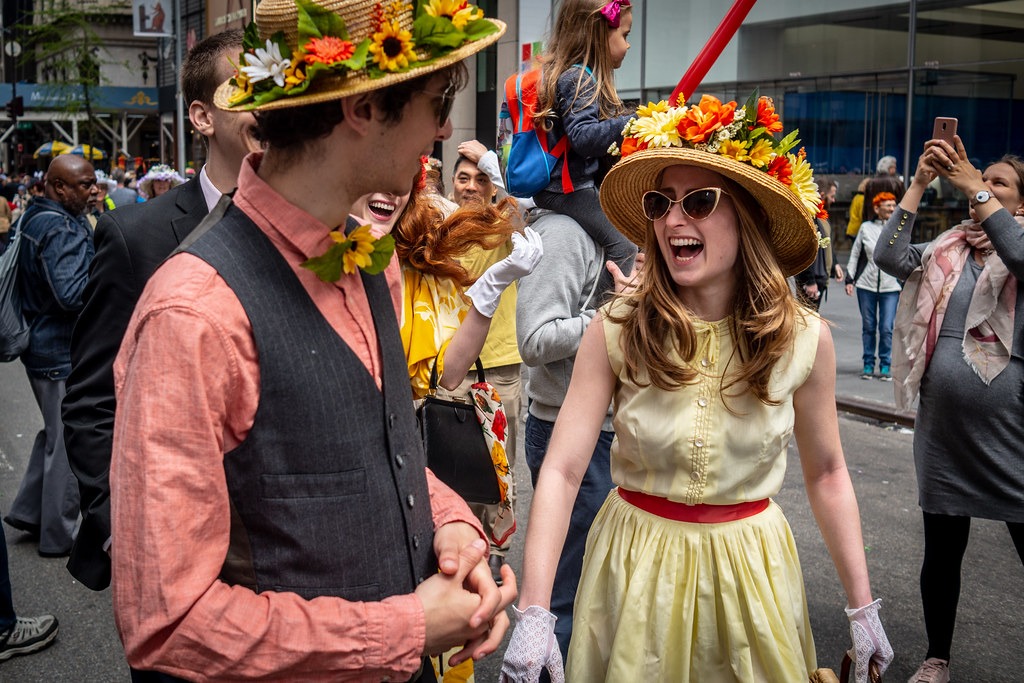Easter bonnets have a long standing history as part of the Easter celebrations which embodying the themes of renewal and rebirth that define this springtime festival. Traditionally, these decorative hats are associated with the joyous parades held in towns and cities across the UK and around the world. Here’s a look into the background, trends, and significance of Easter bonnets today.
Origins of the Easter Bonnet
The tradition of wearing new clothing during Easter can be traced back to early Christianity, where it symbolised new beginnings and the resurrection of Christ. Over time, this ritual expanded, with the Easter bonnet becoming a key feature for women to showcase their finest spring attire. In the 19th century, women would either buy a brand-new bonnet or embellish an older one with fresh decorations like ribbons, lace, and flowers in time for the Easter parades.
Evolution of Easter Bonnet Styles
During the 18th and 19th centuries, Easter bonnets were influenced heavily by the fashion trends of the time. In the late 1700s, elaborate powdered wigs and towering hairstyles were in vogue, making room for bonnets with extravagant trimmings like feathers, pearls, and silk ribbons. The 19th century saw the introduction of bonnets with wide brims adorned with bows, frills, and clusters of flowers, giving them a more feminine and ornate appearance.
By the Victorian era, bonnets became more subdued in style, often incorporating the use of exotic bird feathers as a sign of status and fashion. This era also marked a darker period for the global bird population, as the demand for rare feathers led to the decimation of numerous species. Conservationists began raising awareness of the issue, which eventually led to a decline in the use of feathers in millinery by the early 20th century.
Easter Bonnets in the 20th and 21st Century
In the 20th century, the Easter bonnet evolved from being a fashionable statement to becoming a more community-focused tradition. By the 1940s and 1950s, the hats were often handmade and more whimsical, incorporating bright colours and simple decorations. This era also popularised the custom of children crafting their own Easter bonnets as part of school activities, which still continues today.
The 21st century has seen a resurgence of Easter bonnet parades, often as community events or fundraisers. The designs have become more varied, drawing inspiration from seasonal themes, animals, and even popular culture. Contemporary Easter bonnets now range from simple floral designs to bold, avant-garde creations that would not look out of place on a fashion runway.
Making Your Own Easter Bonnet
Creating an Easter bonnet is a fun, creative activity that can be enjoyed by both children and adults alike. The process typically involves using a basic hat or headpiece and adorning it with seasonal decorations such as artificial flowers, Easter eggs, ribbons, and lace. Many communities and schools hold Easter bonnet competitions, encouraging participants to come up with the most inventive designs.
If you’re interested in making an Easter bonnet at home then start with a plain straw hat or a headband as the base. From there, you can add various embellishments like flowers, feathers, and decorative eggs to create a unique piece. Alternatively, you can follow online tutorials or download templates to guide your design process. Sites like the UK Centre for Carnival Arts provide resources and inspiration for creating these festive hats.
Easter Bonnet Parades and Their Significance
Easter bonnet parades are still a common sight in many parts of the UK. These parades are joyful events that bring communities together, often featuring competitions where the best-designed bonnet wins a prize. The parades usually take place on Easter Sunday or during the Easter weekend, and participants of all ages join in, showcasing their colourful and creative headwear.
For children, making an Easter bonnet has become a popular school project, where they can express their creativity while learning about the historical and cultural aspects of the holiday. The emphasis is on fun and community spirit, making it an enjoyable tradition for families to participate in.
Current Trends in Easter Bonnets
In recent years, Easter bonnet designs have become more eco-conscious, with many choosing to use sustainable materials like recycled paper, biodegradable glitter, and natural decorations. This shift reflects the growing awareness of environmental issues and the desire to celebrate in a more sustainable manner.
Additionally, many Easter bonnet makers now incorporate elements of carnival and cultural heritage into their designs. Drawing inspiration from vibrant carnival headdresses, modern Easter bonnets can be both a nod to history and a celebration of diverse cultural identities. This blending of tradition with modern aesthetics has kept the Easter bonnet tradition fresh and appealing to a new generation of creators and enthusiasts.
Conclusion: A Timeless Tradition
The Easter bonnet remains an iconic part of Easter celebrations, combining history, creativity, and community spirit. Whether it’s through participating in a parade, making a bonnet at home, or simply appreciating the artistry of others, the Easter bonnet continues to be a symbol of springtime joy and renewal. As the tradition evolves, it adapts to reflect changing societal values while still retaining its core charm.
